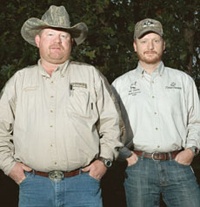Wild Turkey Survival Ain’t No Jive
by September 21, 2009 12:00 am 132 views

Northwest Arkansas might be a poultry company haven, but its wild turkey population is losing habitat.
That’s a problem, experts say, because of conservation and business concerns. Hunting in Arkansas is responsible for retail sales of more than $877.4 million, according to the 2006 National Survey of Fishing, Hunting and Wildlife Associated Recreation.
The resulting economic impact, the study adds, is 17,823 Arkansas jobs. Ducks and deer account for the majority, but all species have their own following.
Doug Williams, owner of Williams Tractor Inc. in Fayetteville, said partnering with nonprofit organizations such as the National Wild Turkey Federation is an effective way for businesses and individuals to support conservation.
Williams said the return from being a corporate sponsor of local NWTF events is more than just financial.
“Farmers are the best conservationists there are,” Williams said. “We have a lot of customers and employees who are both into hunting heritage and conservation, and that’s what the NWTF is about.
“I do believe we get some direct benefit out of it. It’s not all about the monetary return though. Sometimes, it’s just the right thing to do.”
Northwest Arkansas’ six-county wild turkey harvest was down 67 percent this spring to 510 birds from a decade-high 1,553 in 2002, according to the Arkansas Game and Fish Commission. The region includes Benton, Carroll, Washington, Madison, Crawford and Sebastian counties.
Local sportsmen James Barger and Stephan Richardson, both members of the NWTF’s Benton County Longbeards’ chapter, said predator proliferation and urbanization are the leading wild turkey eradicators. Despite limited local hunting seasons, poor brood production and foul weather have still hurt flocks.
Barger, who was recently appointed to the NWTF’s state board, said that’s why it’s important to fund habitat protection and trap-and-transfer programs to rebuild populations. He said predators such as coyotes have a better adaptability than game birds, and better managing the area’s carrying capacity is crucial for all wildlife.
Also a hunter’s education instructor, Barger said the best way to understand “carrying capacity” is “thinking of your own home.”
“If you’ve got four people living there, and suddenly next year there’s eight, then 16,” Barger said. “You’re going to have trouble managing your resources.
“It’s the same out there in the woods, and because we have pushed and affected the wildlife, it’s up to us to help manage their capacity in order to help them have a more humane survival.”
Fight or Flight
Since 1985, NWTF has raised and re-invested more than $2.12 million in Arkansas through its Hunting Heritage Super Fund projects. Those funds are administered jointly by the NWTF, its state chapters and state wildlife agencies.
Investments include $1.29 million for habitat improvement projects including those that have impacted more than 144,852 acres within the state. Projects were completed in 27 locations including Hobbs State Management Area east of Rogers.
There are 63 NWTF chapters in Arkansas including five in the six-county area (available at www.nwtf.org). The NWTF counts about 6,600 members statewide. Barger said the largest local chapters have generated about 700 members.
They’re motivated to get involved, Barger said, because the game birds are so scarce locally that all of Benton County and most of Washington County now have closed fall hunting seasons.
For the decade ended in spring 2009, the statewide wild turkey harvest average was 1,756 per county. In the Business Journal’s six-county coverage area, the same average was 1,052. In Benton and Washington alone, it was 141.
Compare that to the best turkey counties in north central Arkansas – where in 2008 Baxter, Fulton, Randolph, Izard, Sharp, Stone, Independence and Cleburne counties averaged 318 birds each.
“We want to bring the wild turkeys back to a healthy population,” Barger said. “The NWTF is not there to build them up so we can shoot them. It’s there to build a healthy population so the birds can thrive.”
Big Birds
According to the NWTF, since its 1973 inception the group has helped grow the number of wild turkeys in North America from an estimated population of about 1.3 million to more than seven million today.
The nonprofit organization’s 2008 annual report showed assets of about $25.8 million, down about 5 percent from $27.2 million in 2007.
Since 1985, about $300,000 has been spent on education programs in Arkansas including for scholarships, educational programs and work with 4-H and teaching groups.
Gaston Melon, whose namesake Rogers company is another corporate supporter, loves the heritage aspect of the NWTF’s work.
“I support the NWTF because I hope my grandchildren will be able to see the animals,” Melon said.
More than 85 percent of the NWTF’s expenses are related to conservation, program activities and education, according to its annual report. Administration overhead is only 7 percent.
George Thornton, CEO of the NWTF, said sportsmen and sportswomen do the real work.
“They purchase hunting and fishing licenses and donate to nonprofits like the NWTF to fund conservation work that state agencies don’t have the budget to accomplish,” Thornton said. “Corporate partners take it to the next level with contributions that help conserve wildlife and habitat, and preserve great American traditions like hunting … it’s a win-win for corporations, outdoor enthusiasts and conservation.”
